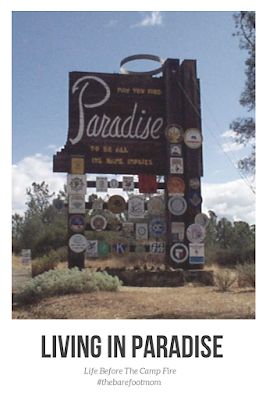So much has been shared in the media lately about the wildfire that all but destroyed Paradise and it's surrounding communities. Everyone has seen pictures of the apocalyptic like destruction. That's not how I want the world to see Paradise. I want people to see it as I will always remember it, and for the way it will be again.
Paradise was a quiet little community nestled in the foothills of the Sierra Nevada mountain range, surrounded by canyons and beautiful evergreens. It was home to about 26,000 of the hardest working and most resilient folks you will ever meet. It was also home to an amazing array of wildlife including mule deer, grey squirrels, raccoons, foxes, California black bears, bobcats, mountain lions, many species of birds, and much more. It was a beautiful place to grow up.
 |
| Mule Deer |
The area was originally inhabited by the Maidu and then settled by gold miners during the California gold rush. The largest true gold nugget ever found in California (and possibly on the North American continent) was found just east of town in the Feather River canyon. The town had several yearly events celebrating the areas rich history, including Gold Nugget Days and Days Of Living History. At the center of these celebrations was a little museum known as the Gold Nugget Museum. In addition to the traditional indoor displays, the Gold Nugget Museum had an amazing outdoor area with replicas of old fashioned buildings, including a school house, a Native American teepee, a covered bridge, and a blacksmith shop. I took my kids to the Days Of Living History event there just a few months before the fire. We got to watch blacksmith and rope making demonstrations, made tin art, went gold panning, and went on a scavenger hunt for native edible and medicinal plants. I am so glad we got the opportunity to enjoy such a neat event!
 |
| Gold Nugget Parade |
 |
The school house at The Gold
Nugget Museum |
I spent my childhood exploring the woods and many creeks in the area, catching water snakes and salamanders. Paradise has some of the most gorgeous swimming holes in the world. My favorite growing up was a beautiful little swimming hole in the Feather River Canyon, called "The Nose" by locals. It's clear water is surrounded by giant boulders that are perfect for jumping off of into the cool pool of water below. Another favorite of mine was commonly referred to as "Rattlesnake Beach" (though in all the time I spent there over the years, I never ran into a single rattlesnake), located in the beautiful Butte Creek Canyon. Locals had built really awesome pools out of intricate rock dams. It was a gorgeous and peaceful little swimming hole, that I often called "my happy place".


Hiking and exploring the natural world is one of my family's favorite activities. Paradise has miles and miles of hiking trails that meander through the woods and along the gorgeous canyons and creeks. Living among so much natural beauty instilled in me a deep love for the natural world. It was such an amazing environment for homeschooling my children in. I feel so blessed to have had the opportunity for my kids to have experienced such beauty and to have developed such a deep connection with nature.
 |
| Butte Creek Canyon |
 |
| Hiking along Butte Creek Canyon |
 |
| Picking wildflowers by the lake |
 |
| Fishing at Lake De Sabla |
Paradise was a beautiful place to live and I am certain it will be again. Already, just barely two months after the fire, people and businesses are returning. Our ice rink, a community favorite, is open. The health center, several auto parts stores, a grocery store, and at least one bank are back up and running. My parents, along with many others, are already making plans to rebuild on their properties. We are a resilient community and I am proud to be a member of such a strong group of people. Like a phoenix, Paradise will rise from the ashes. Though forever changed, I am certain Paradise will be a beautiful place to live again.
If your interested, you can read about my family's experience during the Camp Fire here.















Comments
Post a Comment